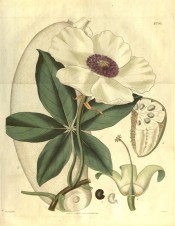Adansonia digitata L.
Frost tender deciduous tree with a thickened, swollen, succulent trunk with short branches bearing rounded, usually 5-9-palmate leaves and pendant white and purple flowers, borne on long stalks, with or just before, the leaves in summer. To 18m. [RHSE].
Horticultural & Botanical History
‘A native of Senegal. It is said likewise to be found in Egypt and Abyssinia, and is besides cultivated in many of the warmer parts of the world. There seems to be no question that it is the largest known tree; the diameter of the trunk, Adanson says, being sometimes no less than thirty feet. Although it has been introduced into Britain, according to the Hortus Kewensis, so long ago as the year 1724, by William Sherard, Esq. yet, as may be supposed, so vast a tree is not likely, in our stoves, to arrive at that size, when its flowers and fruit may be expected.’ [BM t.2791 and t.2792/1828].
The bark of Adansonia digitata was recommended as a treatment for intermittent fevers: ‘The use of this bark he [M. Duchassaing, a physician of Guadaloup] learned from the negroes, who constantly employ it in cases of marsh fever’. [Gard. Chron. 1850].
History at Camden Park
Listed in the 1850 and 1857 catalogues [T.23/1850] but unlikely to have thrived in the Camden gardens.
Notes
Adansonia gregorii F.Muell. is an Australian native, found in the Kimberley district of north west Western Australia. It is possible that Macarthur’s ‘Adansonia digitata’ is gregorii, mistakenly identified as digitata. I have found no record of such a mistaken identity.
Published Feb 20, 2009 - 05:24 PM | Last updated Jul 15, 2010 - 02:06 PM
| Family | Bombacaceae |
|---|---|
| Category | |
| Region of origin | Africa |
| Synonyms | |
| Common Name | Baobab tree, Ethiopian sourgourd, Monkey bread |
| Name in the Camden Park Record | Baobab tree |
| Confidence level | high |


